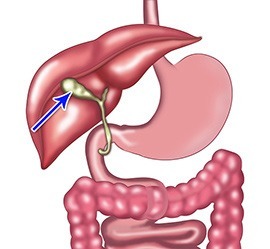Gallbladder Disease Condition
Description
Gallbladder disease is an umbrella term for several conditions affecting the gallbladder. Inflammation of the gallbladder wall (cholecystitis) is responsible for a majority of the gallbladder diseases. Diseases of the gallbladder include gallstones, gallbladder polyps, gallbladder cancer.

Causes
Most cases of cholecystitis are associated with the presence of stones in the gallbladder. Usually gallstones do not cause any problem or symptoms, but may sometimes block the gall bladder outlet, trapping the bile in the gallbladder. The trapped bile causes inflammation of the walls of the gallbladder, leading to swelling and pain. The inflamed gallbladder may also become infected.
Rarely, cholecystitis occurs without the presence of gallstones. This type of acute cholecystitis is referred to as acalculous cholecystitis. It is a more serious form of cholecystitis and tends to occur with gallbladder injury during surgery, prolonged fasting, critical illnesses or when a problem with the immune system occurs.
Impact
Gallbladder diseases can impact your health significantly by causing severe abdominal pain and decreased quality of life.
Anatomy
The gallbladder is a hollow pear-shaped organ that lies just below the liver. Its primary function is to store bile, a thick yellow-green liquid produced in the liver. Bile aids in the digestion of fatty foods. Stored bile drains out from the gallbladder into the common bile duct, which opens into the small intestine.
Symptoms
Gallbladder disease leads to severe abdominal pain. The pain is felt on the right side of the upper abdomen or the upper abdomen and may travel to the back or right shoulder. Other symptoms may include nausea, vomiting and fever.
Diagnosis
Problems with the gallbladder are diagnosed by reviewing your medical history and performing a thorough physical examination. Your doctor may recommend X-ray imaging or abdominal ultrasound to detect the presence of gallstones which may be blocking the path of bile and thickening the gallbladder wall. Blood tests may be ordered to check for signs of infection, obstruction and jaundice.
Treatments
Treatments depend on the type of gallbladder disease. Initial treatment of cholecystitis may include antibiotics however in the presence of gallstones surgery may be the treatment of first choice.
When you experience multiple gallbladder episodes, a surgery called cholecystectomy is most often recommended. The surgery can be performed through a less invasive keyhole approach or the traditional open surgery to remove the gallbladder.
Prognosis
Fortunately, the gallbladder is an organ you can live without. Gallbladder removal most often results in complete recovery and does not require a specific diet after the surgery.
Untreated
If left untreated the gallbladder becomes severely infected, causing some of the tissue to die and decay resulting in septicaemia (blood poisoning), a life threatening condition. In some cases the gallbladder may even burst or an abnormal channel may develop between the gallbladder and gut due to the inflammation.





